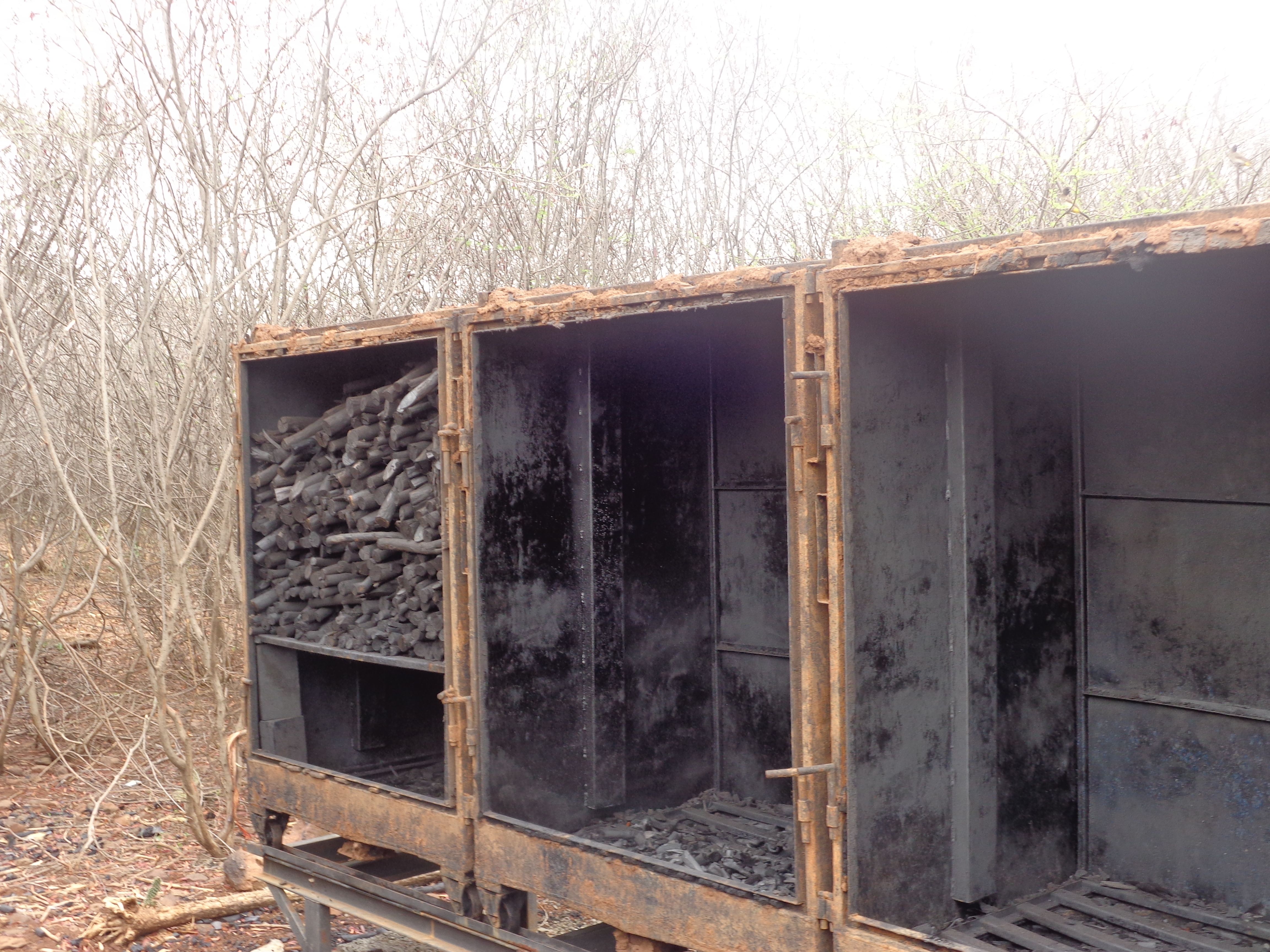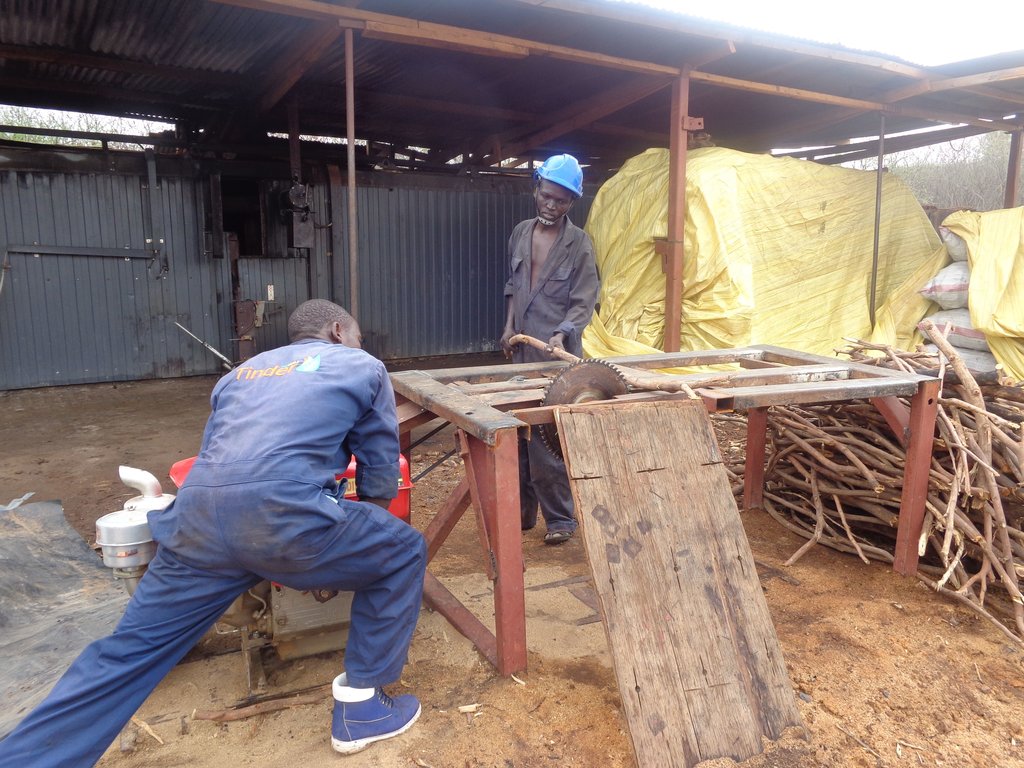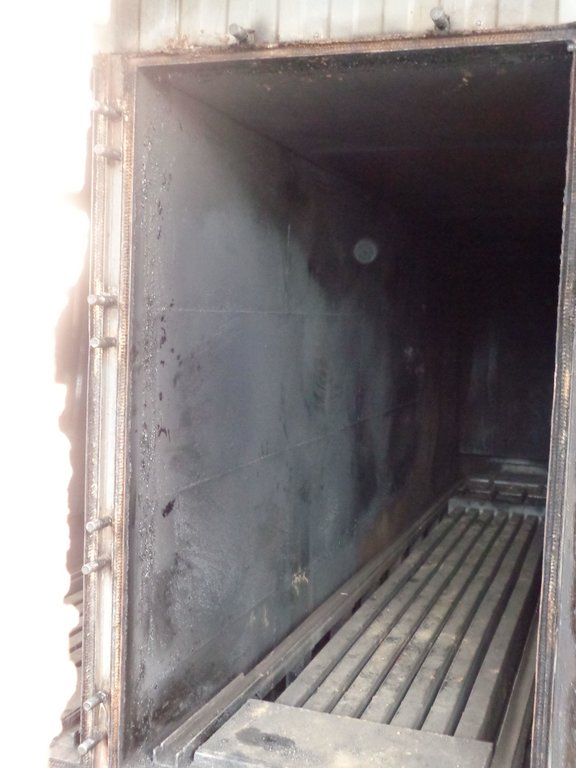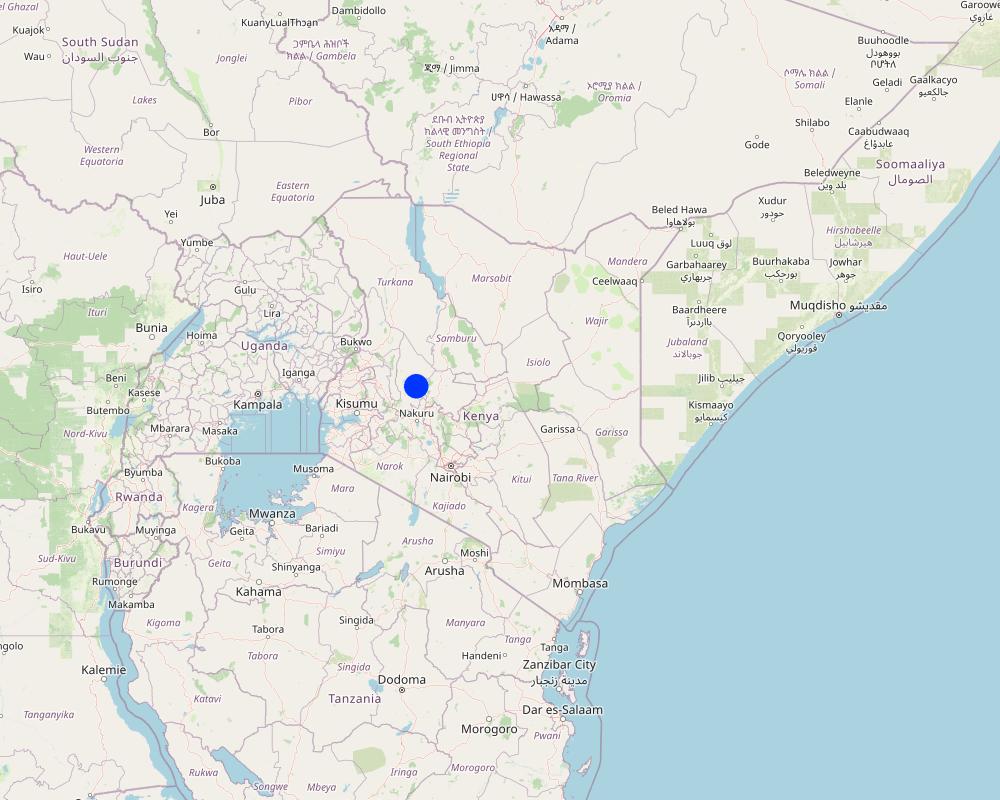Utilisation of invasive species biomass for charcoal production [Kenya]
- Creation:
- Update:
- Compiler: Beatrice Otieno
- Editors: Albrecht Ehrensperger, Christian Hergarten
- Reviewer: Ross Shackleton
Utilisation of invasive species biomass for charcoal production
technologies_3475 - Kenya
View sections
Expand all Collapse all1. General information
1.2 Contact details of resource persons and institutions involved in the assessment and documentation of the Technology
Key resource person(s)
land user:
Name of project which facilitated the documentation/ evaluation of the Technology (if relevant)
R4D Woody WeedsName of the institution(s) which facilitated the documentation/ evaluation of the Technology (if relevant)
CDE Centre for Development and Environment (CDE Centre for Development and Environment) - Switzerland1.3 Conditions regarding the use of data documented through WOCAT
When were the data compiled (in the field)?
13/03/2018
The compiler and key resource person(s) accept the conditions regarding the use of data documented through WOCAT:
Ja
1.4 Declaration on sustainability of the described Technology
Comments:
The main objective of the technology was to minimize environmental pollution through environmentally friendly production processes, uphold preservation of threatened indigenous species by using invasive Prosopis juliflora as a feed stock thereby reducing its woody biomass as well as controlling its spread. However, it is reported that such extractions of the tree parts for charcoal production purposes enhances coppicing, facilitating further invasion. Although disputed by recent research work, the potentiality of control through utilization in managing Prosopis spread is still uncertain. However, there are chances that unless integrated by other management strategies involving active land restorative measures as documented in technologies 3444 and 3455, charcoal production may not sustainably control the spread of Prosopis juliflora.
2. Description of the SLM Technology
2.1 Short description of the Technology
Definition of the Technology:
Charcoal production from invasive Prosopis juliflora has several objectives. It has been promoted to control the spread and reduce the abundance of invasive Juliflora while generating income opportunities for poor rural households producing and selling charcoal. Wood pyrolysis is an efficient, environmentally friendly charcoal production technology through indirect heating of wood at high temperatures with the release of water vapor.
2.2 Detailed description of the Technology
Description:
The use of invasive Prosopis wood for charcoal production is intended to control its spread, create space for agricultural or grazing activities and restore degraded land.
Tinder Eco fuels limited is a private company whose aim is to efficiently produce charcoal through modern, environmental friendly techniques using the ‘EURO’ line charcoal kilns. Approximately 60 tons of invasive Prosopis wood are collected weekly, ejecting an estimate of Ksh. 400,000 weekly income to the local community.
Prosopis, the only tree in Baringo permitted for charcoal production is cut by land users and dried for three days to lower its water content before being transported to the production firm. The trees are then weighed and cut into 15 cm lengths, a corresponding dimension of the loading and offloading trolleys. In the carbonizing chambers, the raw materials are subjected to indirect burning and consequent cooling by pyrolysis gas heated at 250 – 500 degree celcius, a process that takes 8-16 hours. Operations in the chambers are controlled and regulated by an assembly of sensors. Ready charcoal is offloaded into a winch which is covered and sealed by a sandy-clay mixture for further cooling to prevent combustion.
Land users prefer this technology to the traditional one as it is more efficient with a guaranteed income from the sale of Prosopis wood. The carbonization process is fine-tuned, minimizing smoke production and the number of point sources of pollution through household-based traditional charcoal production. A steady production process that is resilient to rainy seasons ensures market readiness and reduces price fluctuations. Clearing the land from invasive Prosopis increases the land's economic and ecological value and the provision of mutliple ecosystem services relevant for local people.
2.3 Photos of the Technology
2.5 Country/ region/ locations where the Technology has been applied and which are covered by this assessment
Country:
Kenya
Region/ State/ Province:
Baringo County
Further specification of location:
Marigat Sub-County
Comments:
No precise location, rather indication of area where the technology is being implemented.
Map
×2.6 Date of implementation
Indicate year of implementation:
2015
2.7 Introduction of the Technology
Specify how the Technology was introduced:
- through projects/ external interventions
Comments (type of project, etc.):
The technology was established by a private company to transform traditional to a modern environmentally friendly charcoal production technique while advocating for the protection of indigenous tree species threatened by invasive Prosopis.
3. Classification of the SLM Technology
3.1 Main purpose(s) of the Technology
- improve production
- reduce, prevent, restore land degradation
- conserve ecosystem
- preserve/ improve biodiversity
- mitigate climate change and its impacts
- create beneficial economic impact
- create beneficial social impact
- enhance provision of multiple ecosystem services
3.2 Current land use type(s) where the Technology is applied

Forest/ woodlands
(Semi-)natural forests/ woodlands:
- Selective felling
- Dead wood/ prunings removal
Products and services:
- Fuelwood
Comments:
The cleared lands, unless located within the irrigated farmlands where cultivation usually follows, are usually left idle allowing Prosopis to coppice and the harvesting cycle continues.
If land use has changed due to the implementation of the Technology, indicate land use before implementation of the Technology:
The challenge with charcoal production from prosopis is that without supporting measures and interventions, prosopis may not be reduced. Therefore it is very important to define a clear goal before implementing the technology. If complete eradication of prosopis is the goal, then charcoal production from prosopis can only be a technology to cover the transition from prosopis to e.g. agriculture or pasture.
3.3 Further information about land use
Water supply for the land on which the Technology is applied:
- rainfed
Specify:
Prosopis is an evergreen tree and easily regenerates and becomes invasive without any human intervention. Cutting of stems or uprooting without a restorative measure in place facilitates their ability to coppice and re-germinate due to the resistant nature of their seeds.
3.4 SLM group to which the Technology belongs
- natural and semi-natural forest management
- pastoralism and grazing land management
- energy efficiency technologies
3.5 Spread of the Technology
Specify the spread of the Technology:
- applied at specific points/ concentrated on a small area
Comments:
While charcoal production is most efficiently achieved in a centrally located production facility, the woody material from invasive Prosopis typically originates from heavily invaded areas easily accessible and close to the prodcution facility. The size of the facility's catchment area typically depends on the level of invasion.
3.6 SLM measures comprising the Technology

vegetative measures
- V3: Clearing of vegetation
- V4: Replacement or removal of alien/ invasive species

management measures
- M5: Control/ change of species composition
3.7 Main types of land degradation addressed by the Technology

biological degradation
- Bs: quality and species composition/ diversity decline
3.8 Prevention, reduction, or restoration of land degradation
Specify the goal of the Technology with regard to land degradation:
- reduce land degradation
Comments:
If accompanying measures are put in place, then the technology can also contribute to restore and rehabilitate degraded land.
4. Technical specifications, implementation activities, inputs, and costs
4.1 Technical drawing of the Technology
4.3 General information regarding the calculation of inputs and costs
Specify how costs and inputs were calculated:
- per Technology unit
Specify unit:
Charcoal production plant
Specify volume, length, etc. (if relevant):
1
Indicate exchange rate from USD to local currency (if relevant): 1 USD =:
100.0
4.4 Establishment activities
| Activity | Type of measure | Timing | |
|---|---|---|---|
| 1. | Construction | Structural | once during the plant establishment |
| 2. | Machine installation | Structural | once during the plant establishment |
4.5 Costs and inputs needed for establishment
| Specify input | Unit | Quantity | Costs per Unit | Total costs per input | % of costs borne by land users | |
|---|---|---|---|---|---|---|
| Labour | machine installation (35% of machine cost) | Men | 14.0 | 50000.0 | 700000.0 | 100.0 |
| Equipment | ‘EURO’ line charcoal kiln | a set | 1.0 | 2000000.0 | 2000000.0 | 100.0 |
| Equipment | welding machine | unit | 1.0 | 22000.0 | 22000.0 | 100.0 |
| Equipment | cutting disk | unit | 1.0 | 1800.0 | 1800.0 | 100.0 |
| Construction material | Operations' shade | building | 1.0 | 100000.0 | 100000.0 | 100.0 |
| Other | business operations permit | operations permit | 1.0 | 20000.0 | 20000.0 | 100.0 |
| Total costs for establishment of the Technology | 2843800.0 | |||||
4.6 Maintenance/ recurrent activities
| Activity | Type of measure | Timing/ frequency | |
|---|---|---|---|
| 1. | Transportation of wood from land users | Management | daily |
| 2. | Cutting of wood | Structural | daily |
| 3. | Loading into carbonizers | Structural | daily |
| 4. | Packing of ready charcoal | Structural | daily |
4.7 Costs and inputs needed for maintenance/ recurrent activities (per year)
| Specify input | Unit | Quantity | Costs per Unit | Total costs per input | % of costs borne by land users | |
|---|---|---|---|---|---|---|
| Labour | Technical employees | monthly salary | 12.0 | 60000.0 | 720000.0 | 100.0 |
| Labour | Casual workers | monthly salary | 3.0 | 20000.0 | 60000.0 | 100.0 |
| Plant material | wood | tonne | 3360.0 | 1200.0 | 4032000.0 | 100.0 |
| Plant material | water | |||||
| Other | permit | 1.0 | 20000.0 | 20000.0 | 100.0 | |
| Other | electicity | amperes | 180.0 | 267.0 | 48060.0 | 100.0 |
| Other | water | litres | 54000.0 | 0.8 | 43200.0 | 100.0 |
| Total costs for maintenance of the Technology | 4923260.0 | |||||
4.8 Most important factors affecting the costs
Describe the most determinate factors affecting the costs:
Weather conditions may affect transportation of wood due to poor rural road condition
Power outages
5. Natural and human environment
5.1 Climate
Annual rainfall
- < 250 mm
- 251-500 mm
- 501-750 mm
- 751-1,000 mm
- 1,001-1,500 mm
- 1,501-2,000 mm
- 2,001-3,000 mm
- 3,001-4,000 mm
- > 4,000 mm
Specify average annual rainfall (if known), in mm:
671.00
Agro-climatic zone
- semi-arid
Average annual rainfall in mm: 671.0
Rainfall is characterized by seasonal and annual uctuations
The area is in a semi-arid zone with temperatures ranging
between 16 to 36 degrees, averagely 24.6 degrees, accompanied
by high evaporation rates of up to 6mm. It experiences an
average rainfall of 671 mm annually which are very erratic.
5.2 Topography
Slopes on average:
- flat (0-2%)
- gentle (3-5%)
- moderate (6-10%)
- rolling (11-15%)
- hilly (16-30%)
- steep (31-60%)
- very steep (>60%)
Landforms:
- plateau/plains
- ridges
- mountain slopes
- hill slopes
- footslopes
- valley floors
Altitudinal zone:
- 0-100 m a.s.l.
- 101-500 m a.s.l.
- 501-1,000 m a.s.l.
- 1,001-1,500 m a.s.l.
- 1,501-2,000 m a.s.l.
- 2,001-2,500 m a.s.l.
- 2,501-3,000 m a.s.l.
- 3,001-4,000 m a.s.l.
- > 4,000 m a.s.l.
Indicate if the Technology is specifically applied in:
- not relevant
5.3 Soils
Soil depth on average:
- very shallow (0-20 cm)
- shallow (21-50 cm)
- moderately deep (51-80 cm)
- deep (81-120 cm)
- very deep (> 120 cm)
Soil texture (topsoil):
- medium (loamy, silty)
Soil texture (> 20 cm below surface):
- medium (loamy, silty)
Topsoil organic matter:
- low (<1%)
5.4 Water availability and quality
Availability of surface water:
good
Water quality (untreated):
poor drinking water (treatment required)
Is flooding of the area occurring?
Ja
5.5 Biodiversity
Species diversity:
- low
Habitat diversity:
- low
Comments and further specifications on biodiversity:
Marigat is heavily invaded by Prosopis which have out competed native vegetation and grasses, threatening biodiversity.
5.6 Characteristics of land users applying the Technology
Sedentary or nomadic:
- Sedentary
Market orientation of production system:
- mixed (subsistence/ commercial
Off-farm income:
- 10-50% of all income
Relative level of wealth:
- poor
Individuals or groups:
- individual/ household
- groups/ community
Level of mechanization:
- manual work
- mechanized/ motorized
Gender:
- women
- men
Age of land users:
- youth
- middle-aged
5.7 Average area of land owned or leased by land users applying the Technology
- < 0.5 ha
- 0.5-1 ha
- 1-2 ha
- 2-5 ha
- 5-15 ha
- 15-50 ha
- 50-100 ha
- 100-500 ha
- 500-1,000 ha
- 1,000-10,000 ha
- > 10,000 ha
Is this considered small-, medium- or large-scale (referring to local context)?
- medium-scale
5.8 Land ownership, land use rights, and water use rights
Land ownership:
- communal/ village
Land use rights:
- communal (organized)
Water use rights:
- open access (unorganized)
5.9 Access to services and infrastructure
health:
- poor
- moderate
- good
education:
- poor
- moderate
- good
technical assistance:
- poor
- moderate
- good
employment (e.g. off-farm):
- poor
- moderate
- good
markets:
- poor
- moderate
- good
energy:
- poor
- moderate
- good
roads and transport:
- poor
- moderate
- good
drinking water and sanitation:
- poor
- moderate
- good
financial services:
- poor
- moderate
- good
6. Impacts and concluding statements
6.1 On-site impacts the Technology has shown
Socio-economic impacts
Production
crop production
crop quality
fodder production
fodder quality
animal production
wood production
forest/ woodland quality
Comments/ specify:
Coppicing of the cut trees slightly increases the woody biomass of Prosopis weed.
product diversity
land management
Comments/ specify:
Land management is simplified on condition that other restorative measures are incorporated
Income and costs
farm income
diversity of income sources
economic disparities
workload
Socio-cultural impacts
community institutions
Comments/ specify:
Charcoal production has led to the establishment of community-based charcoal production associations which regulate all transactions relating to charcoal production, marketing and sale.
SLM/ land degradation knowledge
Comments/ specify:
Am initial directive restricting charcoal production to Prosopis trees enhanced the protection of indigenous trees , creating awareness on the need for their management.
6.2 Off-site impacts the Technology has shown
impact of greenhouse gases
6.3 Exposure and sensitivity of the Technology to gradual climate change and climate-related extremes/ disasters (as perceived by land users)
Gradual climate change
Gradual climate change
| Season | Type of climatic change/ extreme | How does the Technology cope with it? | |
|---|---|---|---|
| annual rainfall | increase | moderately |
Climate-related extremes (disasters)
Hydrological disasters
| How does the Technology cope with it? | |
|---|---|
| general (river) flood | not well |
6.4 Cost-benefit analysis
How do the benefits compare with the establishment costs (from land users’ perspective)?
Short-term returns:
very negative
Long-term returns:
positive
How do the benefits compare with the maintenance/ recurrent costs (from land users' perspective)?
Short-term returns:
negative
Long-term returns:
very positive
6.5 Adoption of the Technology
- single cases/ experimental
Of all those who have adopted the Technology, how many have did so spontaneously, i.e. without receiving any material incentives/ payments?
- 90-100%
Comments:
Although traditional charcoal production is widespread among the households in the community, the eco-friendly power generation technology has been adopted by only one private farm due to the initial high cost of acquiring machinery to carry out the operations
6.6 Adaptation
Has the Technology been modified recently to adapt to changing conditions?
Nee
6.7 Strengths/ advantages/ opportunities of the Technology
| Strengths/ advantages/ opportunities in the land user’s view |
|---|
| Fast and efficient means of producing charcoal compared to traditional technologies as it produced 3 times the amount of charcoal from the same quantity of wood within 16 hours compared to 1 week. |
| Readily available raw materials at affordable price |
| A reliable source of income to the community members |
| Strengths/ advantages/ opportunities in the compiler’s or other key resource person’s view |
|---|
| Environmentally friendly technology of utilizing Prosopis weed with reduced number of point sources for air pollution. |
| Improved community well-being through assured high income from the sale of Prosopis wood compared to their initial practice of tideous traditional charcoal burning and sale. |
| Potentiality in sustainably managing Prosopis / invasive species if integrated with other restorative land management strategies. |
6.8 Weaknesses/ disadvantages/ risks of the Technology and ways of overcoming them
| Weaknesses/ disadvantages/ risks in the land user’s view | How can they be overcome? |
|---|---|
| Poor roads and power shortages during rainy seasons hinders transportation of wood and charcoal production processes as reliance on a fuel generator increases production costs | Improving the road network |
| Corruption and associated assault by police during transportation of charcoal to the market. | Establishment of transparent and clear laws on legal requirements related to charcoal production activities |
| Unsteady regulatory and policy frameworks disrupting charcoal production |
| Weaknesses/ disadvantages/ risks in the compiler’s or other key resource person’s view | How can they be overcome? |
|---|---|
| Unsustainability in controlling invasive species | Integration with other land restoration measures to control re-invasion. |
7. References and links
7.1 Methods/ sources of information
- field visits, field surveys
1
Tinder Eco-fuels Limited
- interviews with land users
3
7.2 References to available publications
Title, author, year, ISBN:
Spatial Evolution of Prosopis Invasion and its Effects on LULC and Livelihoods in Baringo, Kenya. Mbaabu et al. 2019.
Available from where? Costs?
https://doi.org/10.3390/rs11101217
Title, author, year, ISBN:
Experimental prosopis management practices and grassland restoration in three Eastern African countries. Eschen et al, 2023.
Available from where? Costs?
https://doi.org/10.1186/s43170-023-00163-5
Title, author, year, ISBN:
Chapter 12. A REVIEW OF BEST MANAGEMENT PRACTICES FOR THE CONTROL OF INVASIVE PROSOPIS TREES
Available from where? Costs?
Forthcoming (Schaffner et al. 2024)
Links and modules
Expand all Collapse allLinks
No links
Modules
No modules







